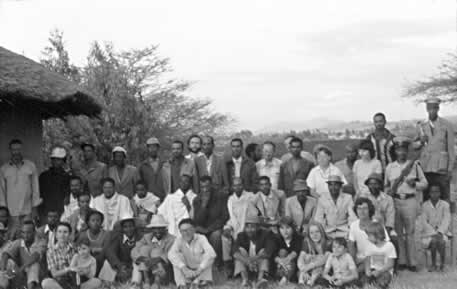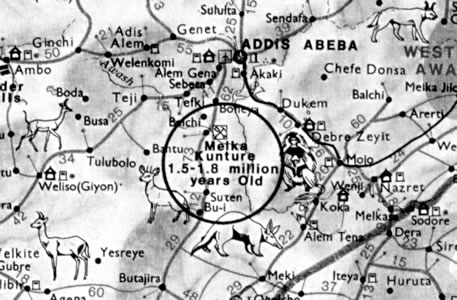The French Archaeological Mission
 The team of Melka Kunture on 1976
The team of Melka Kunture on 1976
Gérard Bailloud, a specialist of the French and European Neolithic, understood that Dekker's discovery was unprecedented.
Accordingly, he organized in 1964 the first archaeological survey, collecting thousands of surface finds. After Kella, more Acheulean sites were discovered at Gombore (now Gombore II, locality 1) on the right bank of the Awash, and at Godeti (now Garba I).
He labelled lithic assemblages of later age as "Stillbay" and "Magosian" industries - a terminology not any more in use today in Ethiopia - and published his first results in a small book edited in Addis Ababa.
The following year, Jean Chavaillon was officially appointed to conduct research and excavations at Melka Kunture.
Chavaillon's activities at Melka Kunture
More Middle-Upper Acheulean sites were soon discovered at Ouaraba, Gombore, Garba, Tuka, Tcharri-Aroussi, Gotu and, later, at Wofi and Simbiro. Chavaillon also discovered, at the Gombore I locality, an Oldowan level similar to those excavated by Louis and Mary Leakey at Olduvai Gorge.
The extremely long sequence of archaeological deposits of Melka Kunture proved to be similar to that of Olduvai. Later prehistoric phases were documented at Kella I, with a Late Stone Age level.
- Oldowan: Karre I, Gombore I, Gombore Iγ, Garba IV;
- Oldowan/Lower Acheulean: Garba XII;
- Lower Acheulean: Simbiro III;
- Middle Acheulean: Gombore II, Gombore II - Hippo site;
- Upper Acheulean: Garba I;
- Final Acheulean/Middle Stone Age: Garba III;
- Late Stone Age: Wofi, Kella;
- Late Stone Age and historic times: Balchit.
 Location of Melka Kunture in a 1992 Ethiopian map
Location of Melka Kunture in a 1992 Ethiopian mapMelka Kunture was awarded international recognition in 1971, when the VII Panafrican Congress of Prehistory and Quaternary Studies was held in Addis Ababa.
A scientific excursion was organised to visit the site. During 1985 and 1992, many of the collection stored in the laboratory of Melka Kunture and in the Museum of Addis Ababa were classified and studied.
Field activity was resumed in 1993, with excavations at Gombore II (both at the main site and at the later "Hippo site"). The archaeological camp was also restored.